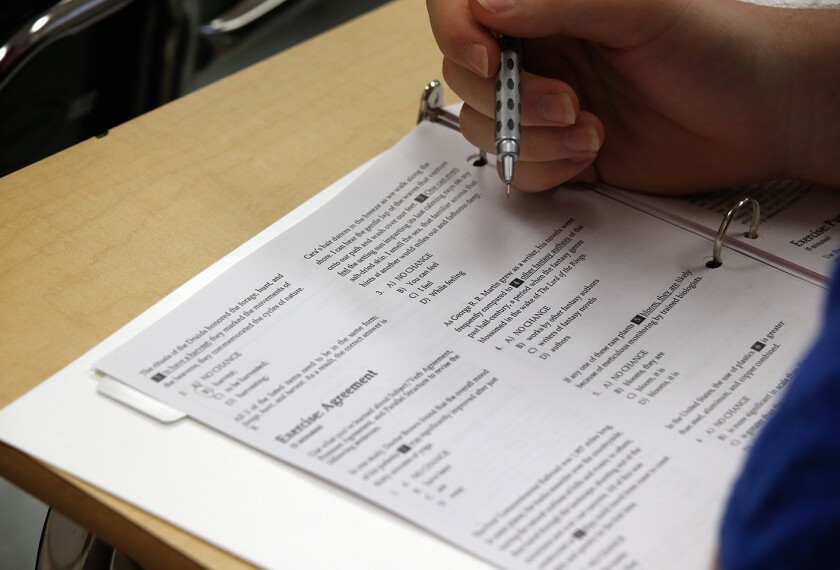A new federal study, drawing on data from five states, found that the charter school students there were less likely to meet state achievement targets than children in regular public schools.
“Evaluation of the Public Charter Schools Program,” is available online from the U.S. Department of Education.
The study also found that charter schools, across the nation, were increasingly more likely to serve minority and low-income students than traditional public schools. However, they were less likely to serve students in special education.
Part of a broad examination of charter schools called for by Congress in 1998, the study is at least the fourth report this fall to stoke a growing national debate over whether such schools on the whole improve achievement. The report draws on data from the late 1990s up to the 2001-02 school year.
See the accompanying item,
Favored by both the Clinton and Bush administrations, charter schools are public schools that are allowed to operate free of many of the rules that govern traditional public schools, often in exchange for pledges to improve student achievement. More than 3,300 such schools now operate across the country, according to the Center for Education Reform, a Washington-based group that promotes them.
Released on Nov. 19, the report was conducted for the U.S. Department of Education by SRI International, a research firm based in Menlo Park, Calif.
Officials with the Education Department, one of the report’s authors, and some independent experts last week downplayed the report’s findings on student achievement, noting that they stemmed from just one year in five states.
“The study is a snapshot and it is impossible to know from one picture whether charter school students are catching up or falling behind,” Eugene W. Hickok, the deputy secretary of education, said in a statement.
The new report’s student-achievement findings were part of a more comprehensive study intended to monitor the federal grant program begun in 1995 to seed the charter school movement.
The study found, for example, that 68 percent of charter school students in Texas met state learning standards during the 2001-02 school year, compared with 98 percent of their peers in regular public schools.
Poor and Minority Students
In Colorado, charter school pupils lagged behind their public school counterparts by 9 percentage points that school year, the report said. In most cases, those differences held up even after researchers adjusted the numbers to account for the higher percentages of poor and minority students attending charter schools.
The American Federation of Teachers was quick to point out that the new findings echo its own national analysis finding that charter school students lag behind those in regular public schools.
That analysis, made public in August, touched off the current debate over achievement in charter schools. It was followed days later by a report from Harvard University researcher Caroline M. Hoxby that came to the opposite conclusion, using different data. (“New Data Fuel Current Charter School Debate,” Sept. 8, 2004.)
According to the new federal study, the percentage of charter school students who are white declined from 48 percent in 1998-99 to 37 percent in 2001-02. Also, 9 percent of charter school students had disabilities, compared with 12 percent of the regular school population.
The report says that charter schools rarely closed, and that more than half of charter school authorizers reported having trouble shutting failing schools. More than one-third of charter schools served students in grades K-8 or K-12, compared with 8 percent of traditional schools.
Attention is more likely to focus on the report’s findings on student achievement, which are drawn from five states where researchers conducted case studies: Colorado, Illinois, Massachusetts, North Carolina, and Texas. Charter school pupils trailed behind their counterparts in traditionally run public schools to one degree or another in all five states.
However, in only two of those states—Colorado and Texas—were researchers able to simultaneously control for differences among schools that can affect test results, such as their racial, ethnic, and socioeconomic makeups or mobility rates.
Helen F. Ladd, a public-policy professor at Duke University in Durham, N.C., who has independently studied charter schools, said the study “doesn’t end the debate on student performance and whether charter schools are more effective than public schools, and the report is straightforward about that.”
Both Ms. Ladd and federal Education Department officials said the achievement findings would be more meaningful if researchers were able to track students’ progress in charter schools over time.
“If anything, it’s simply telling you that the students attending charter schools tend to be worse off academically than the students who attend traditional public schools,” said Nina Shokraii Rees, the deputy undersecretary who heads the department’s office of innovation and improvement.
Several experts suggested that the Education Department was trying to downplay the findings by releasing them the Friday before Thanksgiving week.
An article last week on the report in The New York Times said the report’s release had come in response to a Freedom of Information Act request from that newspaper.
Nancy Adelman, SRI’s project director on the report, said the study was submitted to the department in June. Department officials denied sitting on the report.




